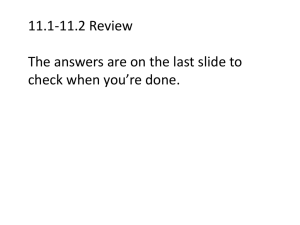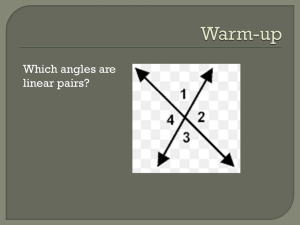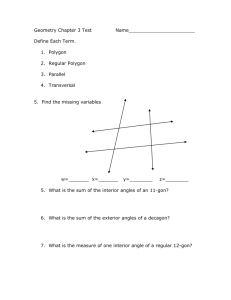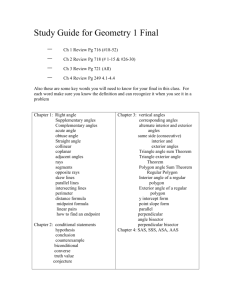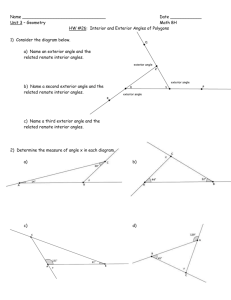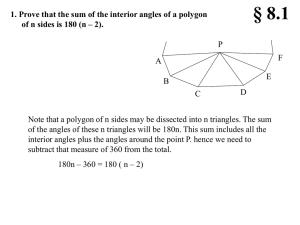Midterm Review2013reg
advertisement
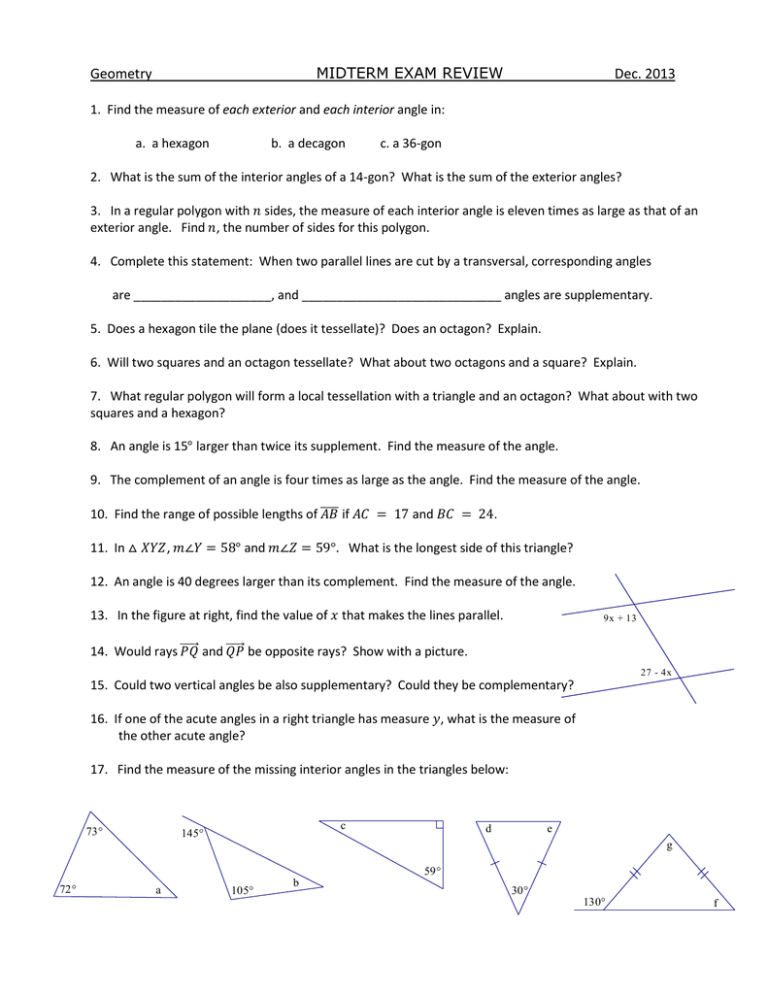
MIDTERM EXAM REVIEW Geometry Dec. 2013 1. Find the measure of each exterior and each interior angle in: a. a hexagon b. a decagon c. a 36-gon 2. What is the sum of the interior angles of a 14-gon? What is the sum of the exterior angles? 3. In a regular polygon with 𝑛 sides, the measure of each interior angle is eleven times as large as that of an exterior angle. Find 𝑛, the number of sides for this polygon. 4. Complete this statement: When two parallel lines are cut by a transversal, corresponding angles are ____________________, and _____________________________ angles are supplementary. 5. Does a hexagon tile the plane (does it tessellate)? Does an octagon? Explain. 6. Will two squares and an octagon tessellate? What about two octagons and a square? Explain. 7. What regular polygon will form a local tessellation with a triangle and an octagon? What about with two squares and a hexagon? 8. An angle is 15° larger than twice its supplement. Find the measure of the angle. 9. The complement of an angle is four times as large as the angle. Find the measure of the angle. 10. Find the range of possible lengths of ̅̅̅̅ 𝐴𝐵 if 𝐴𝐶 = 17 and 𝐵𝐶 = 24. 11. In △ 𝑋𝑌𝑍, 𝑚∠𝑌 = 58° and 𝑚∠𝑍 = 59°. What is the longest side of this triangle? 12. An angle is 40 degrees larger than its complement. Find the measure of the angle. 13. In the figure at right, find the value of 𝑥 that makes the lines parallel. 9x + 13 ⃗⃗⃗⃗⃗ and 𝑄𝑃 ⃗⃗⃗⃗⃗ be opposite rays? Show with a picture. 14. Would rays 𝑃𝑄 27 - 4x 15. Could two vertical angles be also supplementary? Could they be complementary? 16. If one of the acute angles in a right triangle has measure 𝑦, what is the measure of the other acute angle? 17. Find the measure of the missing interior angles in the triangles below: 73 c 145 d e g 59 72 a 105 b 30 130 f 18. Referring to the figure at right, for the information given in each part below, determine which, if any, lines must be parallel and give a reason. a. ∠1 ≅ ∠10 C 4 B d. ∠5 ≅ ∠8 8 3 9 2 E 10 e. 𝑚∠3 + 𝑚∠4 = 180 − 𝑚∠8 f. ∠1 ≅ ∠4 D 6 7 b. ∠5 ≅ ∠2 c. ∠2 ≅ ∠8 5 1 A g. ∠9 ≅ ∠6 F 19. For the figures below, determine whether there are any congruent triangles. Where there are congruent triangles, state the congruence and the reason. A B J P E Q F K M X H D C G L 20. In the figure at right, identify the following: S R P a. a median RT TQ U PV VQ b. an altitude V c. a perpendicular bisector 21. In the figure at right, explain why the altitude and perpendicular bisector are parallel. T R S Q

